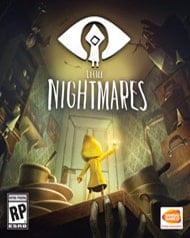Tiny Terror
It would be wrong to glance at the title and misinterpret its meaning as miniscule frights that couldn’t possibly penetrate your tough skin. Little Nightmares is a very disturbing game, one that pulls you back into your childhood and manifests each dreadful fear you had while the darkness of night enveloped your house. It turns those memories into an interactive reality in this horror puzzler. After having their hands in LittleBigPlanet and Tearaway Unfolded , developer Tarsier Studios has taken their side-scrolling platformer skills to grim levels. Here, they pit a frail, nine-year-old girl named Six against the denizens of her house, a prison called The Maw that she is desperately trying to escape.
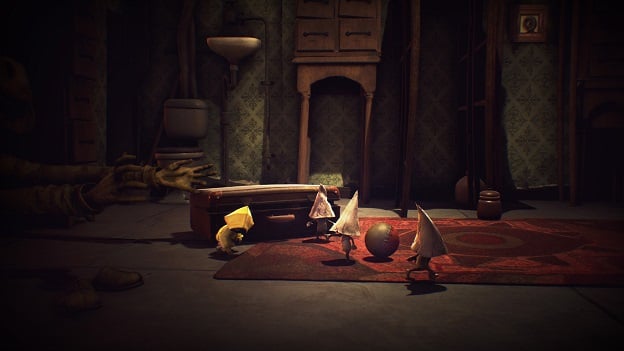
Starting in the depths of a cold steel floored and pipe strewn basement, Six moves from one room to the next. Her singular goal is to locate the room’s exit and discover what needs to be manipulated to access her escape hatch. Nestled around the abstract and enlarged set pieces are objects and furniture to physically influence, some designed to solve your current predicament and others placed simply as a pretense of normalcy. You may cling to a few childish joys, like having Six traipse through a pool of black sludge barefoot and using the floorboards as a canvas for her foot paintings. Or perhaps you will spend a few extra minutes in the toy room, knocking over wooden blocks and dangling on an oversized swing set or chasing a toy train around a merry-go-round, if nothing more than to distract your mind from the electrified prison bars on either side of the room.
The only warmth in Little Nightmares comes from the cigarette lighter Six clutches tightly in her hand; it is her sole weapon against the shadows, her other arm shielding the flame from the wind as she scurries away from worm like monsters trying to constrict the life out of her. Other rooms require caution and patience in order to avoid the petrifying gaze (literally) of the keepers of the house. Eyes are always watching in some form, carved into wooden doors, stamped on toy blocks, and scrawled on the walls, instilling a constant reminder that the adults are always aware.
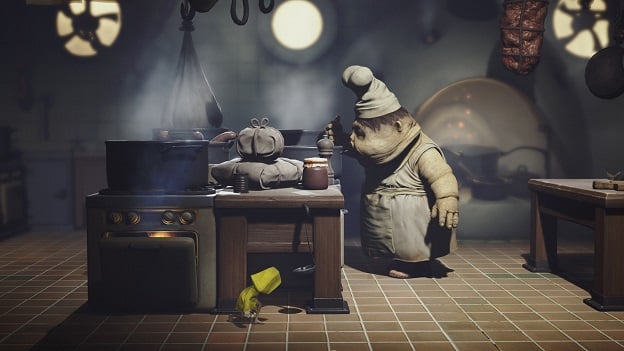
Little Nightmares ’s journey changes pace often. At times you’re given an eternity in a lifeless room, then move to an adjacent room where you have to hide from and tiptoe around a grotesque adult. This could be followed by a chase through a hallway with twenty foot arms mere inches from strangling your scrawny torso. Though this is not a horror game that thrives on jump scares, even the moments of silence had me worried that every new animation could expose me to discovery. I found myself hiding in cages, behind boxes, and anywhere else in the shadows after successfully completing many of the puzzles, wondering if my mischief had stirred any adults and alerted them to my presence.
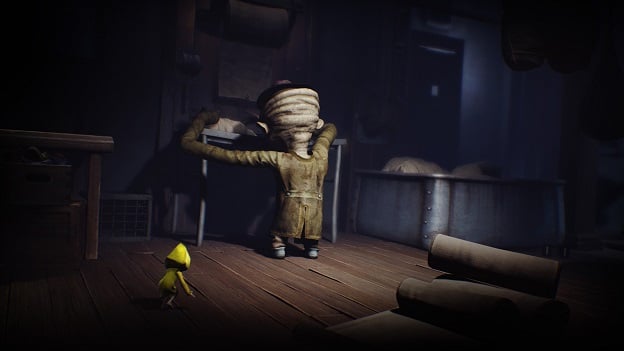
Each warped and artistic frame is either filled with beautiful details and disturbing imagery or purposefully barren, cold, and constricting backdrops to heighten the feelings of solitude. Whether it’s ashtrays spilling over discarded cigarette butts or the dusty remains of other children incinerated by the gaze of a monstrous eye in the wall, you’ll be beckoned to pause and snap the flame on your cigarette lighter not only to check darkened corners, but also just to appreciate the vision the designers and artists put on display. There is a juxtaposition of scale at play in Little Nightmares . Though nine-years-old, from the lens of a child the world seems much larger and imposing, and this contrast is made true with chairs, dresser, and other furniture easily three to four times the size of our toddler heroine. The game also plays off-balance (again, literally), as the world sways like a creaky planked ship on the sea, catalyzing a queasiness within your belly as you shift from side to side while a tube of toilet paper or a tin can rolls along with the teetering camera. Oftentimes, this weight shift plays into solving puzzles, as you time your movements or pulling of a hefty object to access an out of reach switch.
Yet despite a few cleverly designed conundrums, most of the teasers are easily solved; you should reach the games conclusion within a few short hours. It’s a little disheartening actually, considering the potential to delve deeper with the content. There were countless rooms that housed a bevy of possible puzzles, and yet a singular rudimentary and linear answer allowed me to quickly escape to the next area. More rooms could have gone beyond simply running from one end to the other. With the surrealism made factual, the boundaries and complexities could have been stretched much further. There isn’t much to do apart from the task of escape, though you can scour the house for porcelain statuettes, shattering them to signal they have been collected. You can also chase down Nomes (gnomes) and capture them in a hugging embrace. Little Nightmares is likely a story that you will skim through a single time, even though many of the impressions will be lasting.
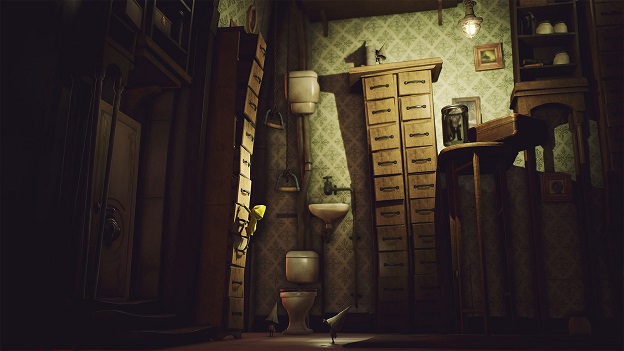
It’s nice to see the horror genre taking on a variety of forms. Little Nightmares follows in the vein of developer Playdead’s Inside and Limbo and offers engaging and disturbing quasi-2D platforming to counterbalance all the zombie shooters and jump scares out there. Tarsier Studios has a great vision and the game is priced right at twenty dollars, but after completing the journey, it feels a little unfinished even after the final period in the story was dotted.
Giving the story a few rounds of proofreading might have inspired the designers to add more obstacles and offered more flexibility to the players. Still, the well-presented aesthetic and emotional impact make Little Nightmares more than worthy of a playthrough.
RATING OUT OF 5 RATING DESCRIPTION 4.4 Graphics
Beautiful yet disturbing, barren yet full of detail, the contradictions make this game a unique visual experience. 4.0 Control
There isn’t much more to do than run, sneak, grab, and pull objects, but the simplicity solidifies the limited capacity of a starved nine-year-old in a prison of a house. 4.2 Music / Sound FX / Voice Acting
Apart from a few up tempo escapes, most of the music is subdued, allowing the echoing drips of water and Six’s padding feet on concrete resonate louder than any orchestra. 3.8 Play Value
The price is right and the impression lasting, but story ends too quickly and the puzzles solved too easily and linearly. 4.1 Overall Rating – Great
Not an average. See Rating legend below for a final score breakdown.
| Review Rating Legend | |||
|---|---|---|---|
| 0.1 – 1.9 = Avoid | 2.5 – 2.9 = Average | 3.5 – 3.9 = Good | 4.5 – 4.9 = Must Buy |
| 2.0 – 2.4 = Poor | 3.0 – 3.4 = Fair | 4.0 – 4.4 = Great | 5.0 = The Best |
Game Features:
